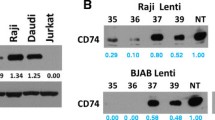Abstract
Fas play a critical role in T-cell apoptosis by functioning as a major cell-surface death receptor. To explore a potential method that can improve the sensitivity to Fas-mediated apoptosis in malignant precursor T-cells. Fas gene was stable transfected into Jurkat cells to establish a new cell line named Jurkat-Fas with over-expressed Fas. RT-PCR, real-time RT-PCR, flow cytometry, and confocal microscopy assay were performed to detect the Fas level of mRNA and protein in the two cell lines. The sensitivities to Fas-mediated apoptosis of the two cell lines were evaluated by flow cytometry with Alexa Fluor 488 annexin V/PI staining in vitro. Tumor xenograft models were prepared with Jurkat and Jurkat-Fas cells for in vivo study. Fas mRNA and protein levels in Jurkat-Fas cell line were higher than that in Jurkat cell line. Compared to Jurkat cells, apoptosis rates of Jurkat-Fas cells were remarkably higher in vitro, and the tumor growth of Jurkat-Fas cells in nude mice was significantly inhibited in vivo. Stable over-expression of extrinsic Fas gene can significantly ameliorate the sensitivity to Fas-mediated apoptosis in human malignant T-cell, which indicates a novel strategy to improve therapeutic effects on precursor T-cell malignancy.







Similar content being viewed by others
References
Hoelzer D, Gokbuget N (2009) T-cell lymphoblastic lymphoma and T-cell acute lymphoblastic leukemia: a separate entity? Clin Lymphoma Myeloma 9(Suppl 3):S214–S221
Brunner T, Mogil RJ, LaFace D et al (1995) Cell-autonomous Fas (CD95)/Fas-ligand interaction mediates activation-induced apoptosis in T-cell hybridomas. Nature 373:441–444
Jones CL, Wain EM, Chu CC et al (2010) Downregulation of Fas gene expression in Sezary syndrome is associated with promoter hypermethylation. J Invest Dermatol 130:1116–1125
van Doorn R, Dijkman R, Vermeer MH et al (2002) A novel splice variant of the Fas gene in patients with cutaneous T-cell lymphoma. Cancer Res 62:5389–5392
Shen L, Liang AC, Lu L et al (2002) Frequent deletion of Fas gene sequences encoding death and transmembrane domains in nasal natural killer/T-cell lymphoma. Am J Pathol 161:2123–2131
Takakuwa T, Dong Z, Takayama H et al (2001) Frequent mutations of Fas gene in thyroid lymphoma. Cancer Res 61:1382–1385
Dereure O, Levi E, Vonderheid EC et al (2002) Infrequent Fas mutations but no Bax or p53 mutations in early mycosis fungoides: a possible mechanism for the accumulation of malignant T lymphocytes in the skin. J Invest Dermatol 118:949–956
Takakuwa T, Dong Z, Nakatsuka S et al (2002) Frequent mutations of Fas gene in nasal NK/T cell lymphoma. Oncogene 21:4702–4705
Osella-Abate S, Zaccagna A, Savoia P et al (2001) Expression of apoptosis markers on peripheral blood lymphocytes from patients with cutaneous T-cell lymphoma during extracorporeal photochemotherapy. J Am Acad Dermatol 44:40–47
Wu J, Nihal M, Siddiqui J et al (2009) Low FAS/CD95 expression by CTCL correlates with reduced sensitivity to apoptosis that can be restored by FAS upregulation. J Invest Dermatol 129:1165–1173
Contassot E, Kerl K, Roques S et al (2008) Resistance to FasL and tumor necrosis factor-related apoptosis-inducing ligand-mediated apoptosis in Sezary syndrome T-cells associated with impaired death receptor and FLICE-inhibitory protein expression. Blood 111:4780–4787
Maeda T, Nakayama S, Yamada Y et al (2002) The conformational alteration of the mutated extracellular domain of Fas in an adult T-cell leukemia cell line. Biochem Biophys Res Commun 296:1251–1256
Beltinger C, Kurz E, Bohler T et al (1998) CD95 (APO-1/Fas) mutations in childhood T-lineage acute lymphoblastic leukemia. Blood 91:3943–3951
Tamiya S, Etoh K, Suzushima H et al (1998) Mutation of CD95 (Fas/Apo-1) gene in adult T-cell leukemia cells. Blood 91:3935–3942
Tawara M, Maeda T, Yamada Y et al (2003) Aberrant processing of Fas transcripts in adult T-cell leukemia: a possible role in tumor cell survival. Cancer Lett 193:235–242
Wohlfart S, Sebinger D, Gruber P et al (2004) FAS (CD95) mutations are rare in gastric MALT lymphoma but occur more frequently in primary gastric diffuse large B-cell lymphoma. Am J Pathol 164:1081–1089
Weller M, Malipiero U, Rensing-Ehl A et al (1995) Fas/APO-1 gene transfer for human malignant glioma. Cancer Res 55:2936–2944
Coleman CN, Cohen JR, Burke JS et al (1981) Lymphoblastic lymphoma in adults: results of a pilot protocol. Blood 57:679–684
Coleman CN, Picozzi VJ Jr, Cox RS et al (1986) Treatment of lymphoblastic lymphoma in adults. J Clin Oncol 4:1628–1637
Colgan JP, Andersen J, Habermann TM et al (1994) Long-term follow-up of a CHOP-based regimen with maintenance therapy and central nervous system prophylaxis in lymphoblastic non-Hodgkin’s lymphoma. Leuk Lymphoma 15:291–296
Chen YC, Ho CL, Kao WY et al (2001) Adult lymphoblastic lymphoma in Taiwan: an analysis of treatment results of 26 patients. Ann Hematol 80:647–652
Burkhardt B, Reiter A, Landmann E et al (2009) Poor outcome for children and adolescents with progressive disease or relapse of lymphoblastic lymphoma: a report from the berlin-frankfurt-muenster group. J Clin Oncol 27:3363–3369
Debatin KM, Krammer PH (2004) Death receptors in chemotherapy and cancer. Oncogene 23:2950–2966
Ashkenazi A, Herbst RS (2008) To kill a tumor cell: the potential of proapoptotic receptor agonists. J Clin Invest 118:1979–1990
Ghobrial IM, Witzig TE, Adjei AA (2005) Targeting apoptosis pathways in cancer therapy. CA Cancer J Clin 55:178–194
Zapata JM, Pawlowski K, Haas E et al (2001) A diverse family of proteins containing tumor necrosis factor receptor-associated factor domains. J Biol Chem 276:24242–24252
Krammer PH (2000) CD95’s deadly mission in the immune system. Nature 407:789–795
Meech SJ, Edelson R, Walsh P et al (2001) Reversible resistance to apoptosis in cutaneous T-cell lymphoma. Ann NY Acad Sci 941:46–58
Ni X, Zhang C, Talpur R et al (2005) Resistance to activation-induced cell death and bystander cytotoxicity via the Fas/Fas ligand pathway are implicated in the pathogenesis of cutaneous T-cell lymphomas. J Invest Dermatol 124:741–750
Author information
Authors and Affiliations
Corresponding author
Rights and permissions
About this article
Cite this article
Li, L., Zhang, R., Chen, Z. et al. Over-expressed Fas improves the apoptosis of malignant T-cells in vitro and vivo. Mol Biol Rep 38, 5371–5377 (2011). https://doi.org/10.1007/s11033-011-0689-2
Received:
Accepted:
Published:
Issue Date:
DOI: https://doi.org/10.1007/s11033-011-0689-2




